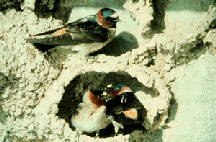A preference for big-city living or small-town life may depend in part on inheritance, at least for cliff swallows.

Five-day-old nestlings that researchers switched to a colony of a different size from their original home grew up to nest in colonies like those of their birth parents, not their foster parents, report Charles R. Brown and Mary Bomberger Brown of the University of Tulsa in Oklahoma. They don’t rule out effects of very early development but suggest inheritance as a strong possible explanation.
“This study is the first on any taxa, to our knowledge, that has measured heritability of group-size preference,” they say in the Dec. 19 Proceedings of the National Academy of Sciences.
After 19 years of studying cliff swallows near Ogallala, Neb., Charles Brown recognizes the tradeoffs of living in colonies ranging from 2 to 3,700 nests. “Forager efficiency is higher in big groups,” he begins. Cliff swallows feed on swarms of flying insects, and the birds routinely follow successful foragers.
Also, nesting in dense arrays can cut nest-construction time, Charles Brown observes. The birds transport mud, pellet by pellet, to build up the walls of a hollow nest into a bulge about the size of a cantaloupe. Starting from scratch takes about 2 weeks. In bigger colonies, birds often share walls with neighbors. With luck, a bird pair can build the equivalent of a townhouse in several days.
Offsetting the conveniences of big-city life are extra parasites, Charles Brown explains. A bed bug that looks like the one that bedevils people specializes in cliff swallows and can kill chicks.
The Browns found that colony size did not seem governed by some previously proposed outside forces. The food available near colony sites didn’t explain size differences, nor did the boundaries of the site itself. “There are some very small bridges that have hundreds of nests under them,” says Charles Brown.
When cliff swallows migrate back to Nebraska for the summer, some return to the colony site of their birth, but others don’t. Examining about 2,500 banded birds that grew up in their birth parents’ nests, the Browns found that their adult choice of colony size resembled parental choice.
In another analysis, the Browns ranked colonies by size in each of five clusters. During 1997 and 1998, the researchers exchanged about 2,000 nestlings between big and small colonies. The researchers managed to recapture nearly 40 percent of these fosterlings when they returned to nest as adults. Fosterlings showed a significant preference for colonies about the same size as their birth parents’ homes.
Taste in colony size might offer a selective advantage to birds if it were linked to some vital trait, Charles Brown says. For example, birds that like a megalopolis could thrive if they resist parasites well.
Judy Stamps of the University of California, Davis applauds the Browns’ approach. Older theories assumed that animal groups have an optimal size “but losers get stuck with colonies too big or too little,” she says. New thinking, Stamps says, allows that “the best habitat is not the same habitat for everyone.” She adds that such preferences could have huge implications for designing preserves for creatures that, unlike cliff swallows, eschew bridges and other trappings of humanity.





